Private Charitable Giving and Welfare: Is State Needed?
VerifiedAdded on 2023/06/13
|5
|1387
|167
Essay
AI Summary
This essay evaluates the argument that private charitable giving can serve as a satisfactory basis for welfare provision without state intervention. It examines the main influences and motives behind private donations, including altruism, public recognition, and the 'warm glow' effect, discussing their implications for social policy. The essay explores whether private donations can lead to a socially optimal outcome, addressing the 'free rider' problem and the potential for market failure. It also contrasts private charity with tax-financed welfare benefits, considering the role of government in income redistribution and the potential for inequality. The conclusion highlights that while charitable giving is a positive force, government intervention is often necessary to achieve socially optimal results and ensure equitable welfare provision. Desklib offers this solution and many other resources for students.
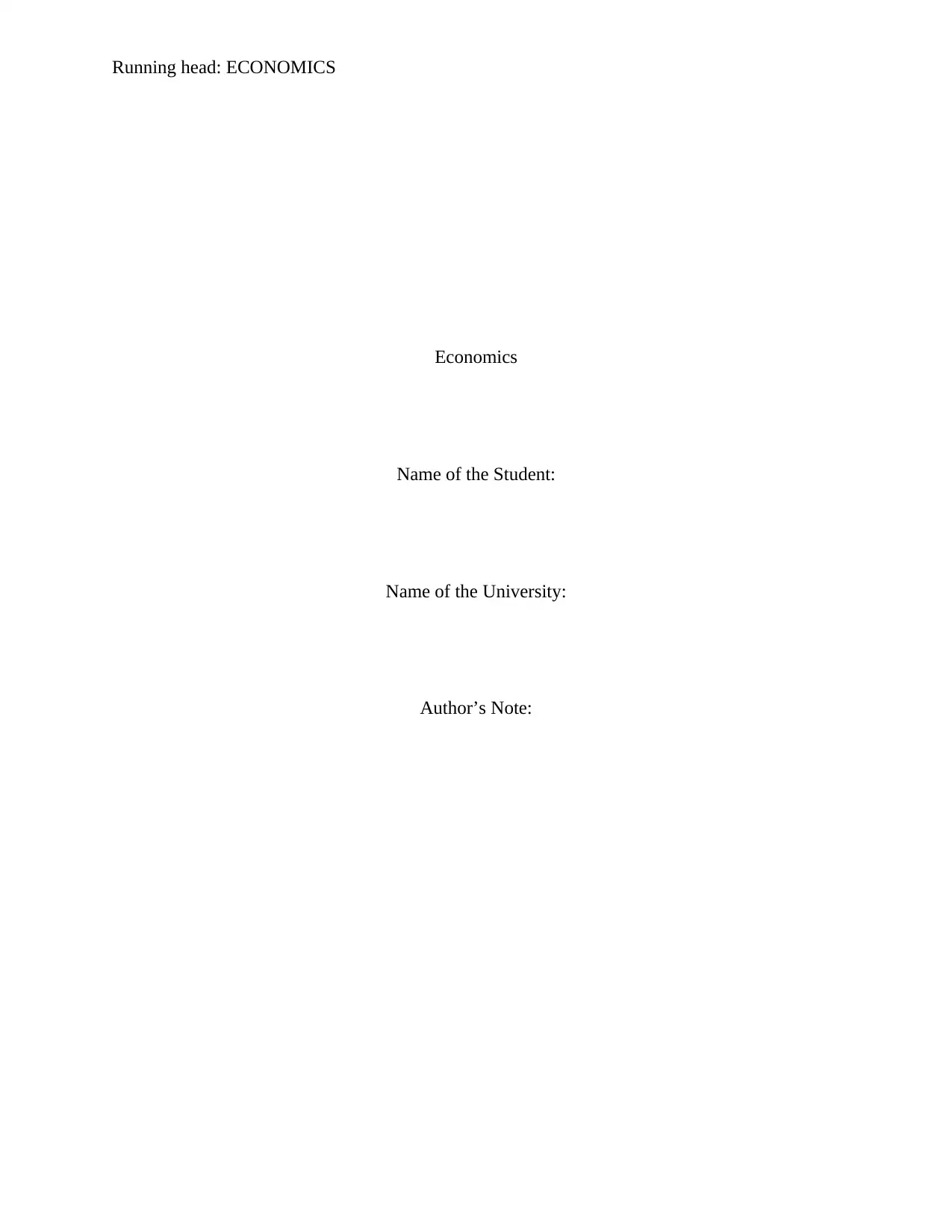
Running head: ECONOMICS
Economics
Name of the Student:
Name of the University:
Author’s Note:
Economics
Name of the Student:
Name of the University:
Author’s Note:
Paraphrase This Document
Need a fresh take? Get an instant paraphrase of this document with our AI Paraphraser
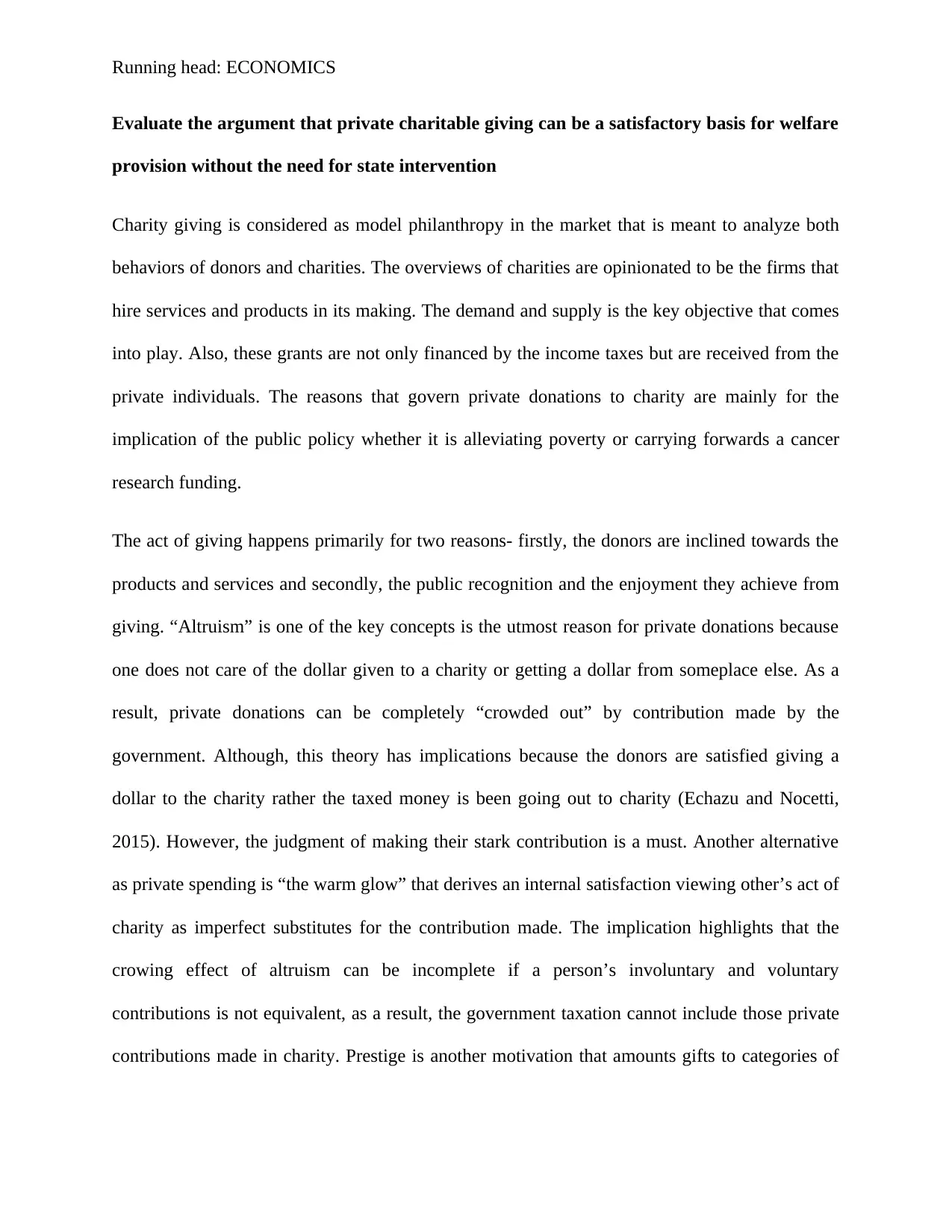
Running head: ECONOMICS
Evaluate the argument that private charitable giving can be a satisfactory basis for welfare
provision without the need for state intervention
Charity giving is considered as model philanthropy in the market that is meant to analyze both
behaviors of donors and charities. The overviews of charities are opinionated to be the firms that
hire services and products in its making. The demand and supply is the key objective that comes
into play. Also, these grants are not only financed by the income taxes but are received from the
private individuals. The reasons that govern private donations to charity are mainly for the
implication of the public policy whether it is alleviating poverty or carrying forwards a cancer
research funding.
The act of giving happens primarily for two reasons- firstly, the donors are inclined towards the
products and services and secondly, the public recognition and the enjoyment they achieve from
giving. “Altruism” is one of the key concepts is the utmost reason for private donations because
one does not care of the dollar given to a charity or getting a dollar from someplace else. As a
result, private donations can be completely “crowded out” by contribution made by the
government. Although, this theory has implications because the donors are satisfied giving a
dollar to the charity rather the taxed money is been going out to charity (Echazu and Nocetti,
2015). However, the judgment of making their stark contribution is a must. Another alternative
as private spending is “the warm glow” that derives an internal satisfaction viewing other’s act of
charity as imperfect substitutes for the contribution made. The implication highlights that the
crowing effect of altruism can be incomplete if a person’s involuntary and voluntary
contributions is not equivalent, as a result, the government taxation cannot include those private
contributions made in charity. Prestige is another motivation that amounts gifts to categories of
Evaluate the argument that private charitable giving can be a satisfactory basis for welfare
provision without the need for state intervention
Charity giving is considered as model philanthropy in the market that is meant to analyze both
behaviors of donors and charities. The overviews of charities are opinionated to be the firms that
hire services and products in its making. The demand and supply is the key objective that comes
into play. Also, these grants are not only financed by the income taxes but are received from the
private individuals. The reasons that govern private donations to charity are mainly for the
implication of the public policy whether it is alleviating poverty or carrying forwards a cancer
research funding.
The act of giving happens primarily for two reasons- firstly, the donors are inclined towards the
products and services and secondly, the public recognition and the enjoyment they achieve from
giving. “Altruism” is one of the key concepts is the utmost reason for private donations because
one does not care of the dollar given to a charity or getting a dollar from someplace else. As a
result, private donations can be completely “crowded out” by contribution made by the
government. Although, this theory has implications because the donors are satisfied giving a
dollar to the charity rather the taxed money is been going out to charity (Echazu and Nocetti,
2015). However, the judgment of making their stark contribution is a must. Another alternative
as private spending is “the warm glow” that derives an internal satisfaction viewing other’s act of
charity as imperfect substitutes for the contribution made. The implication highlights that the
crowing effect of altruism can be incomplete if a person’s involuntary and voluntary
contributions is not equivalent, as a result, the government taxation cannot include those private
contributions made in charity. Prestige is another motivation that amounts gifts to categories of
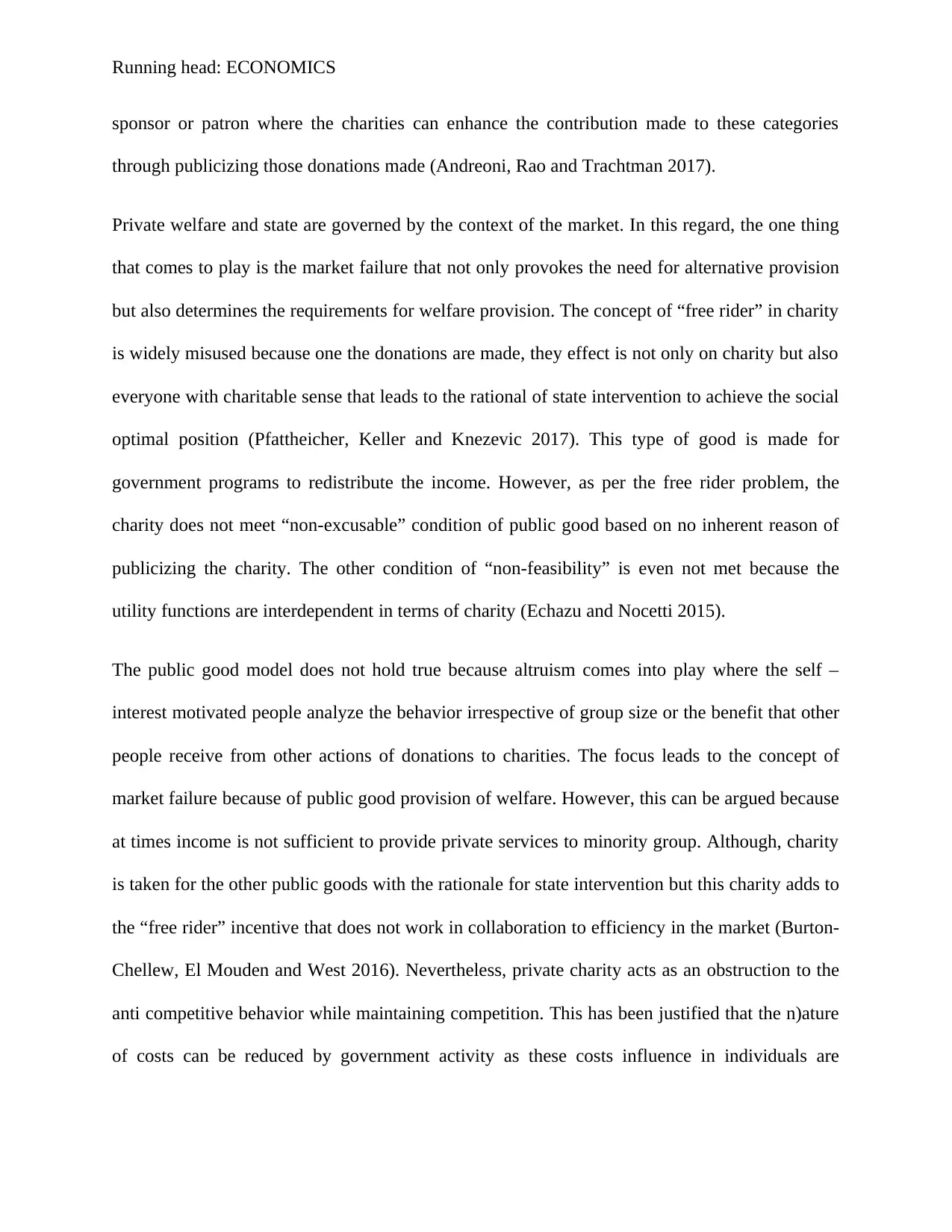
Running head: ECONOMICS
sponsor or patron where the charities can enhance the contribution made to these categories
through publicizing those donations made (Andreoni, Rao and Trachtman 2017).
Private welfare and state are governed by the context of the market. In this regard, the one thing
that comes to play is the market failure that not only provokes the need for alternative provision
but also determines the requirements for welfare provision. The concept of “free rider” in charity
is widely misused because one the donations are made, they effect is not only on charity but also
everyone with charitable sense that leads to the rational of state intervention to achieve the social
optimal position (Pfattheicher, Keller and Knezevic 2017). This type of good is made for
government programs to redistribute the income. However, as per the free rider problem, the
charity does not meet “non-excusable” condition of public good based on no inherent reason of
publicizing the charity. The other condition of “non-feasibility” is even not met because the
utility functions are interdependent in terms of charity (Echazu and Nocetti 2015).
The public good model does not hold true because altruism comes into play where the self –
interest motivated people analyze the behavior irrespective of group size or the benefit that other
people receive from other actions of donations to charities. The focus leads to the concept of
market failure because of public good provision of welfare. However, this can be argued because
at times income is not sufficient to provide private services to minority group. Although, charity
is taken for the other public goods with the rationale for state intervention but this charity adds to
the “free rider” incentive that does not work in collaboration to efficiency in the market (Burton-
Chellew, El Mouden and West 2016). Nevertheless, private charity acts as an obstruction to the
anti competitive behavior while maintaining competition. This has been justified that the n)ature
of costs can be reduced by government activity as these costs influence in individuals are
sponsor or patron where the charities can enhance the contribution made to these categories
through publicizing those donations made (Andreoni, Rao and Trachtman 2017).
Private welfare and state are governed by the context of the market. In this regard, the one thing
that comes to play is the market failure that not only provokes the need for alternative provision
but also determines the requirements for welfare provision. The concept of “free rider” in charity
is widely misused because one the donations are made, they effect is not only on charity but also
everyone with charitable sense that leads to the rational of state intervention to achieve the social
optimal position (Pfattheicher, Keller and Knezevic 2017). This type of good is made for
government programs to redistribute the income. However, as per the free rider problem, the
charity does not meet “non-excusable” condition of public good based on no inherent reason of
publicizing the charity. The other condition of “non-feasibility” is even not met because the
utility functions are interdependent in terms of charity (Echazu and Nocetti 2015).
The public good model does not hold true because altruism comes into play where the self –
interest motivated people analyze the behavior irrespective of group size or the benefit that other
people receive from other actions of donations to charities. The focus leads to the concept of
market failure because of public good provision of welfare. However, this can be argued because
at times income is not sufficient to provide private services to minority group. Although, charity
is taken for the other public goods with the rationale for state intervention but this charity adds to
the “free rider” incentive that does not work in collaboration to efficiency in the market (Burton-
Chellew, El Mouden and West 2016). Nevertheless, private charity acts as an obstruction to the
anti competitive behavior while maintaining competition. This has been justified that the n)ature
of costs can be reduced by government activity as these costs influence in individuals are
⊘ This is a preview!⊘
Do you want full access?
Subscribe today to unlock all pages.

Trusted by 1+ million students worldwide
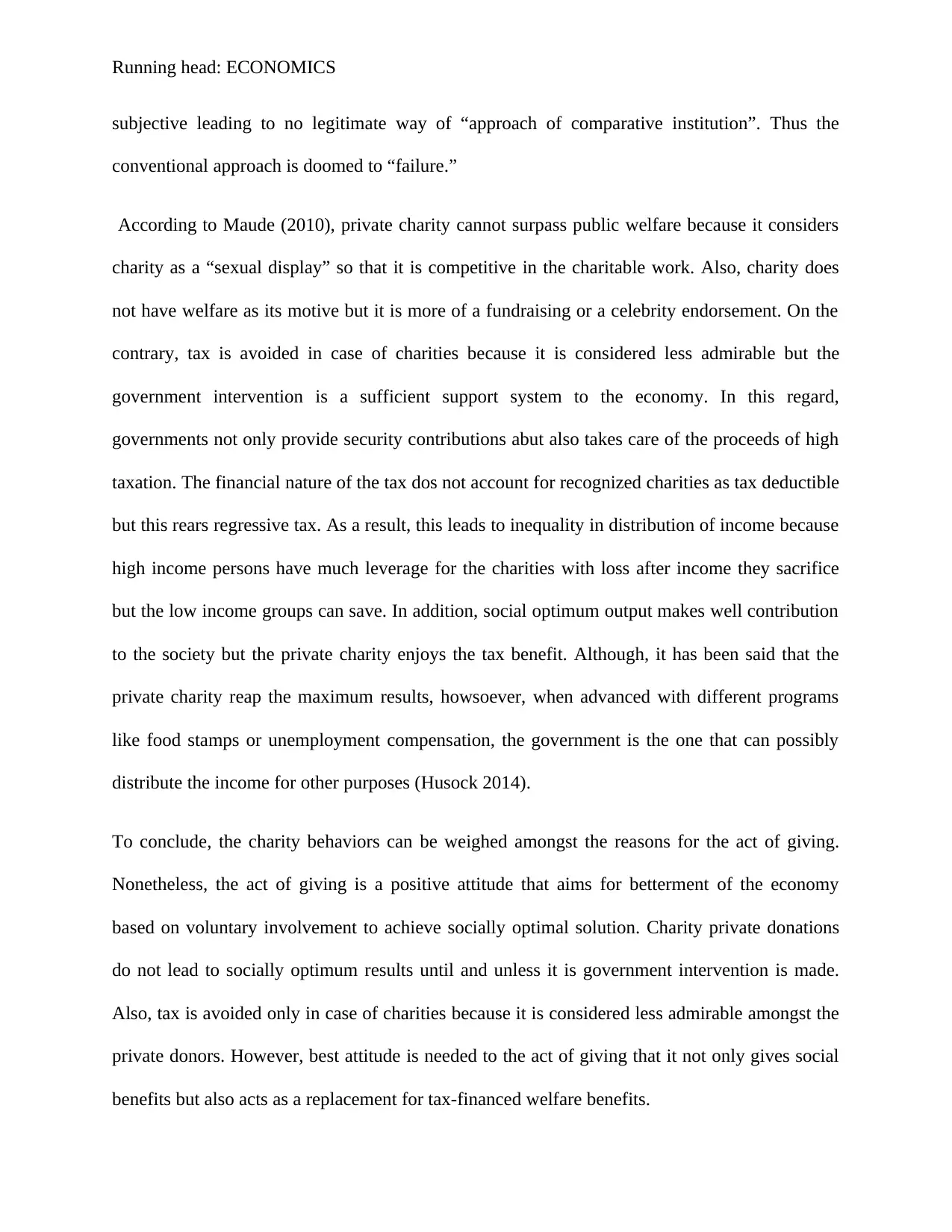
Running head: ECONOMICS
subjective leading to no legitimate way of “approach of comparative institution”. Thus the
conventional approach is doomed to “failure.”
According to Maude (2010), private charity cannot surpass public welfare because it considers
charity as a “sexual display” so that it is competitive in the charitable work. Also, charity does
not have welfare as its motive but it is more of a fundraising or a celebrity endorsement. On the
contrary, tax is avoided in case of charities because it is considered less admirable but the
government intervention is a sufficient support system to the economy. In this regard,
governments not only provide security contributions abut also takes care of the proceeds of high
taxation. The financial nature of the tax dos not account for recognized charities as tax deductible
but this rears regressive tax. As a result, this leads to inequality in distribution of income because
high income persons have much leverage for the charities with loss after income they sacrifice
but the low income groups can save. In addition, social optimum output makes well contribution
to the society but the private charity enjoys the tax benefit. Although, it has been said that the
private charity reap the maximum results, howsoever, when advanced with different programs
like food stamps or unemployment compensation, the government is the one that can possibly
distribute the income for other purposes (Husock 2014).
To conclude, the charity behaviors can be weighed amongst the reasons for the act of giving.
Nonetheless, the act of giving is a positive attitude that aims for betterment of the economy
based on voluntary involvement to achieve socially optimal solution. Charity private donations
do not lead to socially optimum results until and unless it is government intervention is made.
Also, tax is avoided only in case of charities because it is considered less admirable amongst the
private donors. However, best attitude is needed to the act of giving that it not only gives social
benefits but also acts as a replacement for tax-financed welfare benefits.
subjective leading to no legitimate way of “approach of comparative institution”. Thus the
conventional approach is doomed to “failure.”
According to Maude (2010), private charity cannot surpass public welfare because it considers
charity as a “sexual display” so that it is competitive in the charitable work. Also, charity does
not have welfare as its motive but it is more of a fundraising or a celebrity endorsement. On the
contrary, tax is avoided in case of charities because it is considered less admirable but the
government intervention is a sufficient support system to the economy. In this regard,
governments not only provide security contributions abut also takes care of the proceeds of high
taxation. The financial nature of the tax dos not account for recognized charities as tax deductible
but this rears regressive tax. As a result, this leads to inequality in distribution of income because
high income persons have much leverage for the charities with loss after income they sacrifice
but the low income groups can save. In addition, social optimum output makes well contribution
to the society but the private charity enjoys the tax benefit. Although, it has been said that the
private charity reap the maximum results, howsoever, when advanced with different programs
like food stamps or unemployment compensation, the government is the one that can possibly
distribute the income for other purposes (Husock 2014).
To conclude, the charity behaviors can be weighed amongst the reasons for the act of giving.
Nonetheless, the act of giving is a positive attitude that aims for betterment of the economy
based on voluntary involvement to achieve socially optimal solution. Charity private donations
do not lead to socially optimum results until and unless it is government intervention is made.
Also, tax is avoided only in case of charities because it is considered less admirable amongst the
private donors. However, best attitude is needed to the act of giving that it not only gives social
benefits but also acts as a replacement for tax-financed welfare benefits.
Paraphrase This Document
Need a fresh take? Get an instant paraphrase of this document with our AI Paraphraser
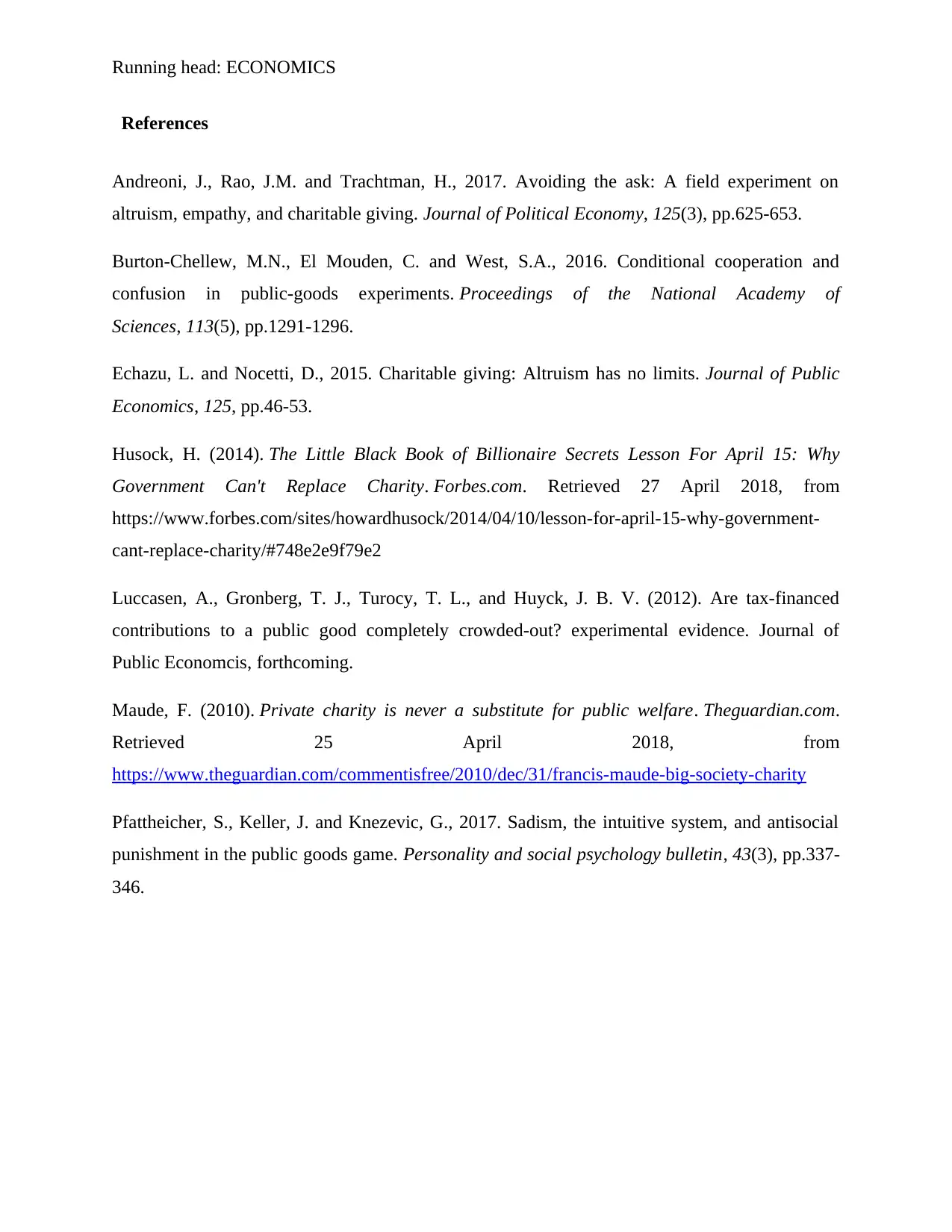
Running head: ECONOMICS
References
Andreoni, J., Rao, J.M. and Trachtman, H., 2017. Avoiding the ask: A field experiment on
altruism, empathy, and charitable giving. Journal of Political Economy, 125(3), pp.625-653.
Burton-Chellew, M.N., El Mouden, C. and West, S.A., 2016. Conditional cooperation and
confusion in public-goods experiments. Proceedings of the National Academy of
Sciences, 113(5), pp.1291-1296.
Echazu, L. and Nocetti, D., 2015. Charitable giving: Altruism has no limits. Journal of Public
Economics, 125, pp.46-53.
Husock, H. (2014). The Little Black Book of Billionaire Secrets Lesson For April 15: Why
Government Can't Replace Charity. Forbes.com. Retrieved 27 April 2018, from
https://www.forbes.com/sites/howardhusock/2014/04/10/lesson-for-april-15-why-government-
cant-replace-charity/#748e2e9f79e2
Luccasen, A., Gronberg, T. J., Turocy, T. L., and Huyck, J. B. V. (2012). Are tax-financed
contributions to a public good completely crowded-out? experimental evidence. Journal of
Public Economcis, forthcoming.
Maude, F. (2010). Private charity is never a substitute for public welfare. Theguardian.com.
Retrieved 25 April 2018, from
https://www.theguardian.com/commentisfree/2010/dec/31/francis-maude-big-society-charity
Pfattheicher, S., Keller, J. and Knezevic, G., 2017. Sadism, the intuitive system, and antisocial
punishment in the public goods game. Personality and social psychology bulletin, 43(3), pp.337-
346.
References
Andreoni, J., Rao, J.M. and Trachtman, H., 2017. Avoiding the ask: A field experiment on
altruism, empathy, and charitable giving. Journal of Political Economy, 125(3), pp.625-653.
Burton-Chellew, M.N., El Mouden, C. and West, S.A., 2016. Conditional cooperation and
confusion in public-goods experiments. Proceedings of the National Academy of
Sciences, 113(5), pp.1291-1296.
Echazu, L. and Nocetti, D., 2015. Charitable giving: Altruism has no limits. Journal of Public
Economics, 125, pp.46-53.
Husock, H. (2014). The Little Black Book of Billionaire Secrets Lesson For April 15: Why
Government Can't Replace Charity. Forbes.com. Retrieved 27 April 2018, from
https://www.forbes.com/sites/howardhusock/2014/04/10/lesson-for-april-15-why-government-
cant-replace-charity/#748e2e9f79e2
Luccasen, A., Gronberg, T. J., Turocy, T. L., and Huyck, J. B. V. (2012). Are tax-financed
contributions to a public good completely crowded-out? experimental evidence. Journal of
Public Economcis, forthcoming.
Maude, F. (2010). Private charity is never a substitute for public welfare. Theguardian.com.
Retrieved 25 April 2018, from
https://www.theguardian.com/commentisfree/2010/dec/31/francis-maude-big-society-charity
Pfattheicher, S., Keller, J. and Knezevic, G., 2017. Sadism, the intuitive system, and antisocial
punishment in the public goods game. Personality and social psychology bulletin, 43(3), pp.337-
346.
1 out of 5
Related Documents
Your All-in-One AI-Powered Toolkit for Academic Success.
+13062052269
info@desklib.com
Available 24*7 on WhatsApp / Email
![[object Object]](/_next/static/media/star-bottom.7253800d.svg)
Unlock your academic potential
Copyright © 2020–2025 A2Z Services. All Rights Reserved. Developed and managed by ZUCOL.




